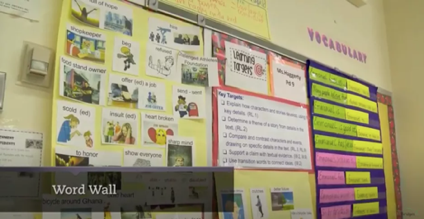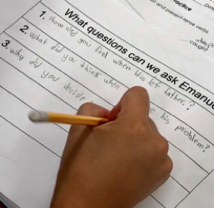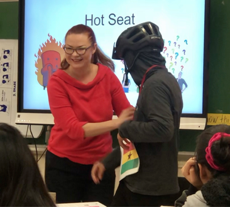Best Practices for Integrating Social-Emotional Learning into Newcomer Classrooms by Lisa Auslander & Virginia Skrelja
Back to BlogBest Practices for Integrating Social-Emotional Learning into Newcomer Classrooms by Lisa Auslander & Virginia Skrelja
In our many years of experience working with schools that serve adolescent Newcomer ELs, we became aware of the challenges students experience before, during, and after the immigration process. For example, in research interviews and focus groups with both teachers and students, we learned that a large number of our undocumented students had crossed the border unaccompanied, lost loved ones along the way, and were no longer as connected to family members or a social network. Once these students arrive, their troubles often are not over. Court dates and paperwork interrupt regular school days, and older students often need to have part-time jobs in order to make ends meet. Newcomer immigrant students may end up working at night and attending school during the day which increases their likelihood of dropping out. Students often face other hurdles, now exacerbated by COVID-19, such as negative stereotyping, transience in their home lives, and food insecurity (Auslander, 2019, pp. 18-24). Research also showed a tendency toward understaffing, particularly in the areas of counseling and social work. The average ratio of social workers and school counselors to students is very steep nationally at around 1 counselor to 482 students (NACAC & ASCA, 2015) In addition to the struggles that come with immigration contexts, we have also found that students can benefit from their immigration experiences. As a result of their life experiences, adolescent newcomers often develop resilience and life skills that other students their age do not possess. Teachers can leverage these skills as well as student interests in the classroom.
Social-emotional learning (SEL) can help Newcomer ELs deal with the many challenges they face as well as further develop skills that will help them progress as adolescent learners . CASEL defines SEL as learning and applying the knowledge, skills, and attitudes to develop healthy identities, manage emotions and achieve personal and collective goals, feel and show empathy for others, establish and maintain supportive relationships, and make responsible and caring decisions'' (CASEL , 2021). Here we provide a few strategies for teachers to integrate these skills into classroom learning to provide Newcomer ELs with the opportunity to become more successful in school and in their lives.
Creating a Welcoming Environment
A safe and welcoming classroom culture is essential for all students, but especially Newcomer ELs. In the classrooms we observed, teachers implemented routines, demonstrated how they valued students and designed collaborative tasks to support students to identify as members of the community and take risks as learners. Maintaining a consistent daily routine alleviates the stress of unknowns for students with trauma and can help them to feel a sense of belonging with their classroom community with its own cultural practices and norms. Teachers show students that they are valued by caring about their learning, encouraging their participation, and giving regular feedback.
Welcoming classrooms encourage Newcomer students who struggle with English to benefit from using their home language to support English acquisition. Teachers in our schools provided dictionaries in the home language, labeled common classroom items in both English and home language(s), and, in some cases, incorporated Walls that Talk: anchor charts and posters in the physical classroom that guide learning, literacy and routines in the home language and build student independence in using classroom resources. Teachers can also partner their students with others who speak the same language to increase their collaboration and meaning-making. Finally, teachers in multilingual classrooms can facilitate the process of students teaching each other about their home language and cultural customs to encourage new learning and respect for one another‘s culture.

Walls that Talk image from a Bridges Classroom and from Padlet
Teaching Self-Regulation in the Classroom
Teaching students to use physical activity as a way of mitigating emotional and physical stress gives them skills that they can use into adulthood. There are several self-regulation and meditation exercises that can be done in the classroom or with a school counselor to give students a break during class time. For example, guiding students either individually or in groups to do breathing exercises, focus on different colors in the classroom, or listen to music during breaks or during a difficult moment can disrupt ruminative thinking. Introducing self-care plans can be another way to teach even younger students how to manage stressors or triggers they experience. For example, we learned that in a Kansas City District, teachers worked together to build Power Plans with their students to help them identify what causes them stress, what can help them prepare for a good day, and then find one thing that can calm them in the moment. In one activity, students at the elementary and middle school level drew out their plans with visuals and talked about them with a partner (Lukens & Homiak, 2018). We found that this activity can be adapted from any age from upper elementary to adult and help students identify their stressors and think ahead to plan creative ways to manage their emotions.
Teaching Social Awareness through Perspective Taking
Developing social awareness is a facet of SEL that supports young people to understand the perspectives of and empathize with others, including those from diverse backgrounds, cultures, and contexts (CASEL, 2021). One way students can develop social awareness is by practicing perspective-taking. Perspective is an essential skill for communicating, collaborating, and problem-solving. Hot Seat is a role-playing activity that extends students‘ understanding of content and language by trying on different perspectives. It is described by Willhelm as an enactment strategy in which students imagine to learn (1998). When participating in Hot Seat, students take on the persona of a character from fiction or an historical figure. They take turns sitting in a chair designated as the hot seat and answering questions from their peers as the character. In one class we observed, students took on the role of Emmanuel, a young man with a deformed right leg who rode his bike across Ghana to advocate for people with disabilities. The teacher provided a bicycle helmet and a Ghanian flag as props for students in the hot seat. Wearing the helmet and flag reinforced to students that their goal was to try to see and explain the world as a young man with a disability might. Students were very engaged in the activity, using English and home language to clarify how they imagined Emmanuel felt when people made assumptions about him based on his disability.


Brainstorming questions Using realia to reinforce
to pose to classmates in the perspective-taking in the
hotseat. hotseat.
Conclusion
Newcomer students, like all students, come into our classrooms, with unique histories, strengths, and needs. However, with the specific challenges that accompany the immigration experience, a holistic approach is required to provide services that will effectively integrate newcomer students into our communities. Our students must rapidly learn English and acculturate to a brand new school system at a time when they may have recently experienced a great deal of upheaval that can make learning difficult. Integrating SEL practices into our classroom routines and instruction can help our Newcomers be successful in achieving their educational goals and contributing to their school communities.
References
Auslander, L. (2019). Creating responsive classroom communities: a cross-case study of schools serving students with interrupted schooling. Lanham, Maryland: Lexington Books.
Lukens, L. & Homiak, C. (2018, March). Incorporating Trauma-Sensitive Practices in K–12 Classrooms With Refugees. Paper presented at the annual meeting of TESOL, Chicago, Illinois.
National Association for College Admission Counseling & The American School Counselor Association (2015). State-by-state student-to-counselor ratio report: 10-year trends. Retrieved from https://www.nacacnet.org/globalassets/documents/publications/research/state-by-state-ratio-report.pdf
Niemi, Karen. CASEL. What is SEL? Retrieved from https://casel.org/what-is-sel/ on February 5, 2021.
Willhelm, Jeffrey (2002). Action strategies for deepening comprehension. New York, New York: Scholastic Inc.
Author Biographies
Lisa Auslander is the Principal Investigator and Project Director of Bridges to Academic Success, a project of CUNY. She served as a teacher, coach and district administrator in New York City schools for over 15 years and is the author of Creating Responsive Classroom Communities: A Cross-Case Study of Schools Serving Students with Interrupted Schooling.
Virginia Skrelja has been working with newcomer ELs for over ten years, first as a teacher at Bronx International High School and now as a Senior Instructional Coach at Bridges to Academic Success.
